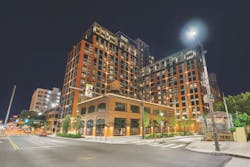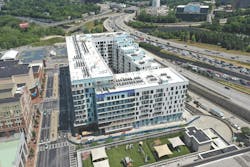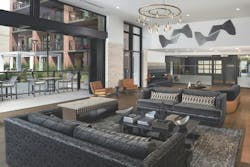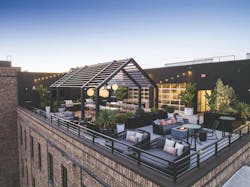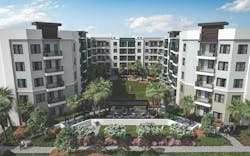Top 10 trends in the luxury multifamily housing market
Luxury: Anything conducive to physical comfort. The enjoyment of sumptuous living. — The American Heritage Dictionary of the English language, New College Edition, 1976
“Luxury isn’t just a word; it’s a way of life.” — Marketing tagline for Bainbridge The Grand, a 390-unit apartment community that opened in Orlando, Fla., in July 2024
Just about every multifamily project that BartonPartners has designed in recent years has marketed itself as a “luxury” property, says Bill Warwick, AIA, a Principal with the Philadelphia-based architecture and urban design firm. That includes Broad + Noble, a $112 million, 19-story building with 344 apartment units developed by Toll Brothers Apartment Living with investment from Sundance Bay, which welcomed its first residents last February.
Broad + Noble showcases many elements that shout luxury living, including lavish lobbies, rooftop lounges, high-quality finishes and fixtures, and robust amenities and services. The tower hovers above a 5,000-sf outdoor plaza and has walkable access to mass transit. Inside, its design highlights include steel framing with precast plank floors, says Jason Ganister, PE, SE, an Associate with O’Donnell + Naccarato, the structural engineer on this project.
10 luxury multifamily trends
- Services split the difference
- Corporate relocations drive luxury demand
- Coworking spaces are must-have amenities
- Flight to quality expands luxury multifamily’s reach
- Toll Brothers embraces apartment living
- Despite strong demand, concessions prevail
- Branding helps buildings project an image
- Technology oils the luxury apparatus
- Rising costs pose construction headwinds
- A bright but more competitive future
However, what demarcates Broad + Noble from other multifamily properties that stamp themselves as “luxury” is harder to discern. Even Warwick concedes that luxury is “subjective, in the eye of the beholder,” and determined by tenants’ experiences. “When they enter, they know it’s something special,” he contends.
The term “luxury” is applied to buildings so liberally these days that “it’s lost some of its cachet,” when affordable and workforce housing use it descriptively, observes Joe Bonora, President of the Tampa, Fla.-based urban infill apartment developer Catalyst Asset Management. He adds that luxury’s effectiveness as a marketing hook gets dulled in places like Tampa, where “there have been a lot of similar products come onto the market in the last 12 to 18 months.”
Still, that hasn’t deterred Catalyst, with Kase Development, from moving forward on Montage at Midtown, a $72 million project on 4.71 acres in Fort Myers, Fla., that, when it’s completed in December 2025, will consist of a four-story luxury apartment building with 320 units, a five-story amenities building with a 5,000-sf fitness center and two terraces, and a six-story, 585-slot parking garage. The building team on this project—which has been approved for an $11.7 million tax increment rebate—includes PDS Architecture and the GC Brooks & Freund.
Demand for luxury multifamily living is strong nationwide, even as financing and rising materials costs can be construction impediments, say the nearly 20 AEC and developer firms that BD+C contacted in July and August to learn what trends are influencing this housing sector’s design and construction. Here’s what we heard:
1. Services split the difference
Luxury in the multifamily space is hard to categorize, partly because it varies by market, location, even by building. Rating systems, like those devised by CoStar, are useful, if understandably ambivalent in their definitions of quality and desirability.
Plus, “there’s always a spectrum within a spectrum,” says Jason Vesuvio, a Vice President with Pavarini McGovern, a division of STO Building Group. That’s especially true, he notes, in markets like New York, Miami, and Los Angeles where skyscrapers encase ultra-luxury residences with seven-, eight-, and even nine-figure price tags.
The proliferation of luxury properties, though, has “changed the story” that once classified buildings solely by how much rent they could fetch. “Now, it’s all about levels of quality and location,” says Matthew Vance, Vice President–Americas Head of Multifamily Research and Senior Economist with CBRE. So, an amenities-rich suburban apartment building could be considered “luxury” by tenants who prefer that lifestyle. For those who lean toward urban living (including Vance), “location is everything, a big deal.”
Boring down a bit deeper, other sources took stabs at defining luxury. Chris Lewis, a Project Executive for Suffolk Construction in Tampa, believes there are “certain minimum requirements to meet the ‘luxury’ standard”: high ceilings, large-format tile/marble or hardwood flooring, full-height cabinets, high-end appliances, large bathrooms and showers, stone countertops, and large kitchen islands with double waterfall edges.
“Attention to detail that surpasses functionality or official criteria,” states Roy Stillman, President of Stillman Development International in New York, whose projects include The Atlantic Club, a 132-unit oceanfront condo building in Long Branch, N.J., that Stillman is codeveloping as part of an LLC called 390 Ocean. “It’s also about understanding the local culture.”
Nicholas Pantuliano, COO and Chief Development Officer with PTM Partners, a Fort Lauderdale, Fla.-based developer, thinks luxury “is less tactile, more experiential.” His firm’s 2000 Biscayne, which opened in June, offers 420 units over 36 floors whose amenities include a 5,000-sf fitness center, wellness spa, TULU room, pool and outdoor yoga area, and EV charging stations.
In Florida, luxury means “catering to a lifestyle of comfort, convenience, and sophistication,” says Bob Thollander, President of Development for Bainbridge Companies. So besides its resort-style pools, well-appointed common areas, and green spaces, Bainbridge The Grand offers concierge services, package delivery management, and on-site maintenance.
Many of the sources interviewed agree that services are what separate luxury multifamily from the rest of the pack. “What sets luxury products apart is exclusive and tailored service,” says Kelly Farrell, Principal and Residential Global Practice Area Leader for Gensler. Robert Fuller, another Principal and Residential Global Practice Area Leader, adds that “living in a luxury development should be more than a transaction; personalized service makes the resident feel special, and builds community.”
Over the years, luxury has evolved to where services “are a big part of being a luxury building,” says Andrew Schwartz, Senior Vice President–Residential Asset Management for the New York-based developer Taconic Partners. He says services often start with the front desk, maintenance staff, and building manager—people who are most visible to tenants and owners.
This emphasis on services accentuates how luxury residential has been taking its cues—like welcoming lobbies, food and beverage options, bed turndowns, even personal shopping experiences and cooking classes—from the hospitality sector, to where “they’ve become incredibly blurred,” says Pantuliano, whose company was about to open its first hotel in St. Petersburg, Fla. This overlap is also evident in Metairie, La., where Latitude, a 150-unit apartment complex set to be completed later this year, is described by its developer, Q Hotels, as being “like a five-star hotel.”
2. Corporate relocations drive luxury demand
There are many drivers of demand for luxury multifamily. Suffolk Construction’s Lewis cites the affluence of younger buyers, competition among various high-end properties, and population densities. Access to destination-driven amenities and experiences is another motivator, says Brooks Howell, Principal and Senior Living Global Practice Area Leader for Gensler.
Population shifts have been instigated, in part, by business-friendlier markets like Houston and Las Vegas that have successfully lured companies away from coastal metros like San Francisco and New York. Between 2018 and 2023, there were 465 corporate headquarters relocations in the U.S., according to CBRE Americas Consulting, with cities in Texas attracting the most moves.
That migration is notable in Atlanta, according to Patrick Fleming, JE Dunn Construction’s Vice President–Commercial Group Manager. Demand for luxury residential, he says, is being spurred by a growing economy and growing population. Atlanta is headquarters to two dozen or so Fortune 500 companies, has the busiest airport in the world, and will host the 2025 Major League Baseball All-Star Game and the 2026 FIFA World Cup.
JE Dunn has several luxury construction projects in this metro, including AMLI Atlantic Station, a $148 million mixed-use building whose 12 stories include 390 housing units, and 25,000 sf of retail and restaurant spaces. Owned by AMLI Residential, this project is scheduled for completion in April 2025. Its luxury amenities include a resort-style pool deck, work-from-home space, fitness center, courtyard, clubroom, and rooftop lounge.
In the Houston community known as The Woodlands, a historically single-family-home enclave, developers are shifting to multifamily projects that include two luxury properties being built by Howard Hughes: 1 Riva Row, a 13-story building with 268 units that is the developer’s first multifamily community to offer penthouses; and The Ritz Carlton Residences with 111 for-sale condos spread over 15 stories.
“Luxury sales are on the rise, as more CEOs relocate their companies and employees, and it’s no accident that this upward trend is happening in The Woodlands,” states Howard Hughes in a written response to BD+C’s questions.
3. Coworking spaces are must-have amenities
In its latest Renter Preference survey, whose results are based on 172,703 respondents to a poll conducted by the National Multi Housing Council (NMHC) in the summer of 2023, the most-sought-after apartment features and amenities ran the gamut: pools, fitness centers, dog grooming, rooftop lounges, yoga studios, 24/7 package delivery access, high-gloss finishes, and premium fixtures and appliances.
The luxury buyer or renter wants all these and expects something more, say AEC and developer sources, like the 75,000 sf of amenities spaces in The Atlantic Club in New Jersey. More developers are installing electric vehicle charging stations in their garages and parking decks, even though only a small fraction of renters currently owns a car, according to NMHC’s survey. (The Atlantic Club will have one EV charger for every three residents, says Stillman.)
Sometimes, the “amenity” is intangible, like a noise-abating lobby inside Taconic Partners’ 34-story, 330-unit residential tower The Ellery, which is located near the cacophonous corner of Manhattan’s 45th Street and 8th Avenue. “We needed to create serenity and calm,” says Schwartz, Taconic’s Senior VP. (The Ellery also offers 41,500 sf of ground-floor retail and grocery space.) Catalyst’s building in Fort Myers, Fla., will provide access to neighborhood amenities via a car-sharing service with three on-premises Teslas.
Vance of CBRE says what distinguishes developers is where they are spending their amenities dollars. And more of those dollars appear to be gravitating toward carving out coworking spaces, both within apartments and the buildings’ common areas.
More than half of the respondents to NMHC’s renter preference survey said they work remotely at least sometimes, and more than two-fifths said they were interested in shared spaces where they live. Several of the AEC and developer sources interviewed say their recent and current luxury residential projects provide coworking options that sometimes include rentable office space.
“A recent universal trend, post-pandemic, is the new normal of hybrid working, so housing that can accommodate and facilitate working from home is a driving factor,” says Tom Silva, Project Director–Design for the general contractor Webcor. “The work-from-home movement has changed everything,” agrees Kevin Ratner, Cofounder and Managing Partner of The Max Collaborative, an Ohio-based builder-developer. “Everyone now is looking for ‘alone/not alone’ space. The whole thing has tumbled into a blender.”
There are numerous examples of this trend. The Ellery, for one, includes four phone and Zoom rooms for private and small-group calls, says Taconic Partners’ Schwartz.
The $32 million, 361-unit Skytop Apartments, designed by Niles Bolton Associates and completed last April in a suburb of Cincinnati, includes business centers that assist coworking and private work-from-home residents, says Brian Ward, AIA, LEED AP, Niles Bolton’s Director of Design. Skytop offers rentable conference rooms, small offices, coffee and beverage bars, and printing services.
4. Flight to quality expands luxury multifamily’s reach
Luxury multifamily isn’t just a coastal phenomenon. In fact, it hasn’t been for quite a while, say AEC and developer sources, as markets around the country are seeing luxury properties spring up to meet burgeoning demand.
“Luxury product can differentiate itself by taking advantage of the DNA of the site,” says Pieter Berger, a Principal with the design firm MVE + Partners. For for-sale luxury demand, MVE is always tracking Southern California, New York, and Miami, whose lifestyle intangibles are hardest to replicate elsewhere. On the luxury rental side, MVE has recently delivered products in Orange County, Calif., Los Angeles, the Bay Area, and Utah, but it also tracks luxury demand in Seattle, Portland, Ore., Austin, Texas, and Nashville, Tenn.
In Nashville, where tourism and entertainment are major draws, “we often find multifamily buildings have multiple Airbnb or rental solutions, not to live,” observes Brooks Rutledge, Vice President with the STO division Layton Construction. Given that dynamic, demand for luxury is not so much for the apartment, per se, but revolves around the urban environment and access to amenities.
Arizona is another rising market for luxury multifamily. Andrew Geier, Layton Construction’s Vice President in Phoenix, says that because Arizona is a vacation and “snowbird” destination, demand for luxury living “really comes down to people who have money and are looking for a ‘lock and leave’ condo, or second home.”
The “flight to quality” that has stimulated demand for luxury living is, in part, a result of a shortage of single-family options, particularly in Sunbelt markets that are experiencing population growth. Vance says CBRE first noticed this regional demand in Houston in 2006, when a handful of residential buildings started getting “way out” rents. Over the next decade, all rents in Houston rose, but rent increases for newer and luxurious apartments “were more average,” says Vance, as the gap between new and existing product had closed. That same pattern occurred in other Sunbelt markets like Tampa and Raleigh, N.C.
However, the belief of many sources that the Sunbelt will continue to be a haven for luxury multifamily development and demand may have gotten rattled when a recent report by Reventure Consulting, a real estate analysis firm, stated that a record-high number of new homes in the U.S. South—293,000 units—were on the market last June, most prominently in Texas and Florida.
Only time will tell if that surplus is a temporary aberration. It’s going to take more than a white paper for developers to pump the brakes on new luxury multifamily projects. In Miami Beach, Fla., Lefferts Development has four mixed-use residential projects under way within a three-block radius of the popular North Beach community. One of these, which was scheduled to open in the summer of 2024, is 72 Park, a 22-story, 266-unit condo tower that’s the first in Miami Beach to permit vacation or short-term rentals. Its 35,000 sf of outdoor amenities include an acre of landscaping and 150-foot-long pool.
5. Toll Brothers embraces apartment living
Toll Brothers is the fourth-largest home builder in the U.S., based on revenue ($9.868 billion) on total deliveries (9,591 units) in 2023, according to ProBuilder magazine. Its strong suit has long been selling McMansions that allow for significant buyer customization. So it’s not surprising that Toll is a national presence, through its Toll Brothers Apartment Living division, in the luxury multifamily sector.
The company did not respond to BD+C’s requests for comment. But according to its latest releases, as of early August Toll Brothers Apartment Living had delivered more than 10,000 units and has another 18,000-plus units in production. (Toll Brothers City Living division, which focuses on for-sale condo construction, had delivered 45 buildings with 7,200 residences.)
Toll Brothers Apartment Living’s growth strategy homes in on “high-quality, high barrier-to-entry” markets. It always develops with repeat joint-venture partners to minimize its risk. And Toll says it is on the prowl for “affordable luxury” opportunities, although it doesn’t specify what these might be.
Broad + Noble, mentioned above, was Toll’s first luxury multifamily community in the Philadelphia market. Its amenities include a ground-floor grand lobby and lounge, a fitness center and flex studio, and an amenity suite on the 18th floor with 360-degree views of the city, a gaming lounge, a media room with a maker space and content creation studio, and a private dining room and entertainment kitchen.
Each home features Caesarstone quartz countertops, stainless steel appliances, designer cabinets, spa-inspired bathrooms, and oversized custom closets. Residents have access to 24/7 concierge service, and secured garage parking with EV charging stations.
Rafferty, designed by MVE + Partners and codeveloped with EJF Capital, began welcoming residents last December. The eight-story building in Santa Ana, Calif., has 218 apartments. It is close to the Calle Cuarto corridor known for its historic district, public art, and cultural institutions.
In late 2024, Toll is scheduled to open The Lindley, a $265 million high-rise in San Diego’s Little Italy neighborhood, which at over 800,000 sf would be one of Toll’s largest developments. The 37-story building, with 422 apartments, will include over 12,000 sf of ground-floor retail space and 222 EV charging stations. Swinterton is the GC on this project, designed by Joseph Wong Design Associates. Toll codeveloped The Lindley with PGIM Real Estate.
Toll is opening three luxury residential apartment buildings in Texas this year, including Remy, a five-story, 357-unit building in Frisco, codeveloped with Equity Residential, that opened in August; and Lyle, another Toll-Equity Residential joint venture, with 334 apartments over five stories, that opened in Dallas in June; and the 420-unit, four-story Whitlow in Lewisville, which received its first guests last February. Toll’s joint development partner on Whitlow was The Davis Companies.
The Laurent, which began receiving residents in October 2023, is Toll’s sixth multifamily development in Massachusetts. Codeveloped with PGIM, the seven-story Laurent, in Cambridge, has 525 luxury apartments and 21,000 sf of amenity space.
6. Despite strong demand, concessions prevail
In its National Multifamily Report, released in April 2024, Yardi Matrix cautioned that in “high supply” Sunbelt markets, developers might take longer to lease apartments without offering concessions.
Reporting that same month on one of Brookfield Properties’ residential towers—the 785-unit Beaudry in downtown Los Angeles, which had been completed a year earlier and was 70% leased—The Real Deal stated that customers who registered for an apartment viewing prompted an email offering discounts that included two months of free rent, a $500 Apple gift card, and three months of free valet service. Another promotion offered a cash discount of between $1,000 and $2,500, depending on the size of the rental unit.
Citing local agents, The Real Deal reported that concessions had become “typical” for luxury apartments in downtown L.A., where 13% of luxury residential units were vacant, according to Marcus & Millichap.
Oversupply is one factor that leads to concessions; another is the customer’s mindset. “Everyone is looking for a deal,” says PTM Partners’ Pantuliano, whose 2000 Biscayne—which was just over 25% leased in mid August—was offering two months free rent on its website.
Vance of CBRE concurs that concessions ebb and flow with supply and demand. He explains that most developers are merchant builders that are interested primarily in leasing up their new buildings as quickly as possible. They are less interested in longer-term ownership and management.
Caitlin Sugrue Walter, NMHC’s Vice President of Research, adds that because luxury residential is generally in newer buildings that are competing against other similar buildings, concessions “make them more attractive to tenants.”
It’s worth noting, says Vance, that the number of luxury buildings offering rent concessions is still in the minority. And developers don’t want to look too desperate by going overboard on discounts. Bonora of Catalyst Asset Management says he prefers not to resort to concessions. “It might take longer to lease, but the tenants tend to be ‘stickier’” when they are lured by a property’s perceived value rather than by short-term enticements.
7. Branding helps buildings project an image
For The Atlantic Club, the developers enlisted a famous Tribeca gallerist to curate and commission globally known artists to create work for the building’s lobby. “We achieved a level of aesthetics that would be enviable in New York and ground-breaking on the Jersey Shore,“ boasts Stillman.
An art-adorned entrance can also be a form of branding, which has become an important aspect in the design and marketing of luxury residential. “The world’s greatest destinations are adding housing to complement and complete a hospitality offering,” observes Gensler’s Farrell. “Branded residences are becoming a strong trend, where for-sale product is delivering all of the luxuries of a five-star hotel,” adds Berger of MVE + Partners, whose design projects include the Mandarin Oriental Residences Beverly Hills.
Vesuvio of Pavarini McGovern notes that a building’s “luxury tone” can be set by the reputation of the architect who designed the building, or the fame of its restaurant’s chef, or even the height of the tower. Indeed, certain design and construction details can reinforce a building’s brand:
• Rutledge of Layton Construction insists that a concrete structure “is a must” because it has the flexibility of footprint and unit layout. And concrete is essential in markets like Nashville, where underground parking “is an absolute premium with a luxury lifestyle.”
• Fleming of JE Dunn Construction says the “basics” of luxury design include LVT (luxury vinyl tile) flooring, frameless cabinets, quartz countertops, stainless steel appliances, and tile showers. He and other sources are also seeing greater demand for customizable closets. (Coincidentally, Pavarini McGovern is currently working on a luxury project in New York City whose residences have faux inset closets that are actually a section of wall which can be removed to combine two units if the tenant wants more space.)
• A building’s “brand,” suggests Ward of Niles Bolton Associates, can also be established by architectural design that presents “dynamic and intentional exteriors that reflect the local context and attention to materials.”
8. Technology oils the luxury apparatus
As luxury multifamily becomes more resort-like and focused on comfort and convenience, residents’ expectations about technology to achieve those aspirations have risen, say AEC and developer sources. This is especially true now, with coworking spaces requiring optimal tech infrastructure in buildings.
“Technology is a critical component of modern luxury multifamily development, enhancing convenience, security, and overall tenant satisfaction,” says Bainbridge Companies’ Thollander. Gail Ruggles, Bainbridge’s Executive Vice President–Operations, adds that luxury tenants view their apartments and condos as “sanctuaries,” with controlled access, high-speed Internet, and smart-home capabilities “at the top of their lists,” as well as the ability to request services, pay rent, and communicate with on-site staff.
Every room in Toll Brothers’ luxury apartment buildings comes with a tech array that includes keyless entry and smart thermostats. Automated features like mechanical window blinds are becoming more common in luxury apartments. And several sources emphasized the importance of strong Wi-Fi signals throughout any luxury building.
Tenants of 2000 Biscayne can access the building’s amenities by downloading the Livly app, which also allows them to stay in contact with the building’s manager, says Pantuliano of PTM Partners.
Geier of Layton Construction notes that luxury multifamily buildings needed to step up their tech games to attract younger tenants who are primary renter and buyer targets. “A high level of technology integration is a requirement,” he says. Niles Bolton’s Ward has seen this trend, too, in the preference for smart-home systems that allow residents to control lighting, heating, and security through their smart phones; as well as the growing demand for smart appliances like touchscreen refrigerators.
Technology also encompasses the performance of a building’s mechanicals. Vesuvio of Pavarini McGovern observes a palpable difference between luxury and market-rate multifamily in their respective MEP systems. “Higher-end buildings have more sophisticated HVAC systems like four-pipe and water-sourced heat pumps, as well as lighter building envelopes,” he says. Vesuvio notes that luxury products are more likely to give “some attention to sustainability.”
9. Rising costs pose construction headwinds
In early July, the San Diego Business Journal reported that high interest rates and rising material costs had put a damper on the construction of luxury apartments in that market, despite high demand. The article quoted Jason Kimmel, Senior Director of Cushman & Wakefield, who claimed that investors were reluctant to commit to building luxury residential towers because high construction costs had made it less expensive to buy existing assets than to build new ones.
The article went on to report that a market turnaround was anticipated within the next two years. But in the here and now, developers and their AEC teams nationwide have been proactive in their efforts to rein in costs.
“While luxury designs are becoming more sophisticated and complex, project schedules and cost requirements are becoming tighter and more challenging,” says Lewis of Suffolk Construction. Like many other GCs, Suffolk has been initiating meetings with developers, architects, engineers, and trade partners much earlier in the building’s lifecycle to make sure everyone is on the same page. “Our project teams leverage data, technology, and AI to increase efficiencies on our projects,” he says.
Among Suffolk’s active projects is The Residences at 400 Central, a 46-story condo tower in St. Petersburg that, at 515 feet, will be one of the tallest buildings on Florida’s West Coast.
Early building team collaboration is also helping Taconic Partners control costs on its luxury projects. The Ellery was designed by Handel Architects and built by Triton Construction, two firms that Taconic Partners has worked with on multiple occasions.
“It all comes down to execution,” says Pantuliano of PTM Partners, “as it’s getting harder and more complicated to build, and the margins aren’t always that great.”
10. A bright but more competitive future
Buildings with five or more housing units were being started at an annualized rate of 460,000 units in June, 6.5% down from the same month a year earlier, according to U.S. Census Bureau estimates.
While none of the sources contacted for this article thought that luxury multifamily construction was on the verge of a precipitous pullback, there were concerns about the Federal Reserve’s resistance to lowering interest rates and its impact on the cost of borrowing. “New starts for luxury apartments will remain low until interest rates start to come down, which will make the product type more appealing as an investment,” predicts JE Dunn’s Fleming.
“Right now, it’s all about financial feasibility,” says NMHC’s Walter. She notes, too, that the recent spurt in luxury multifamily construction could, ironically, lead to longer-term shortages if the government’s current lending policies didn’t ease. (The Fed lowered rates in September.)
Even if shortages don’t emerge, the luxury multifamily sector is likely to remain ultra competitive, perpetuating what Layton Construction’s Geier sees already as an “arms race” in amenities that is recalibrating urban markets. “People seeking a luxury experience are choosing communities in urban centers that used to be considered more residential areas,” states Howard Hughes, “that offer best-in-class amenities integrated into expansive green space, office locations closer to home, community connectivity along with strong family friendly environments with great schools and activities.”
Silva of Webcor sees a “great amount of interest” in creating alternative affordable housing prototypes that provide similar luxury lifestyle options through prefabrication and more efficient delivery methods.
Adaptive reuse also figures into this equation, such as 6 Corners Lofts in Chicago, which held its grand opening on March 18. MG2 was the design-architect, and Novak Construction the developer and GC, on this 394,247-sf conversion of an 80-year-old Sears store that closed in 2018 into a mixed-use building with 38 residential units and a Target department store. The project preserved the building’s Art Deco feel by punching out windows and adding balconies to the studios and lofts. 6 Corners’ amenities include a pool deck, fitness room, dog park, speakeasy, and coworking space.
In essence, the definition of “luxury” will remain mercurial, as more buildings lay claim to its tenants and buyers. Choice will continue to be determined by rent and location, says Schwartz of Taconic Partners. But if every developer is paying more attention to design and construction details, buildings that want to separate themselves as luxury “better be delivering something special.”
About the Author

John Caulfield
John Caulfield is Senior Editor with Building Design + Construction Magazine.
